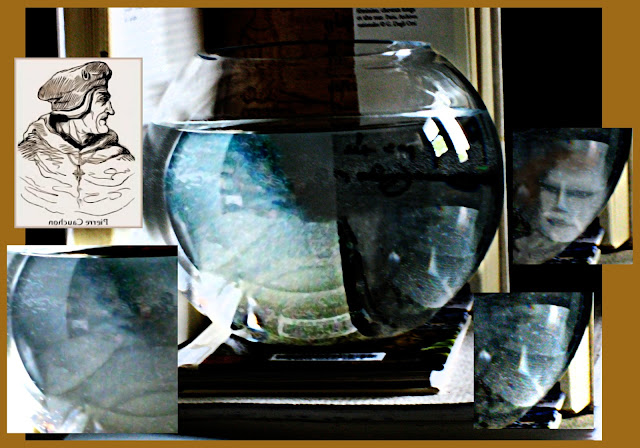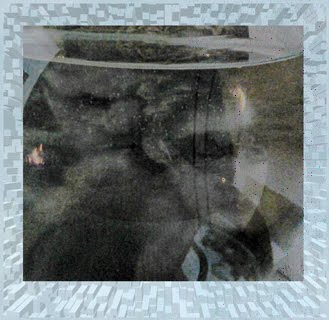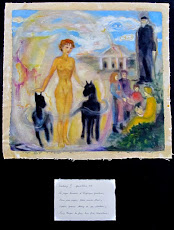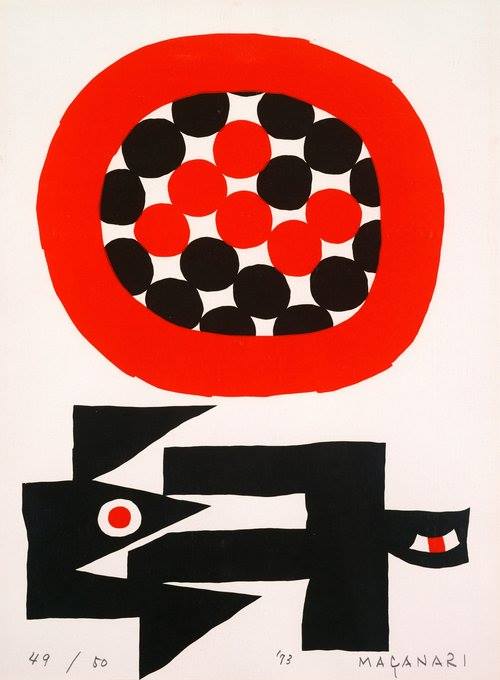 |
| IMG_0895.jpg on the left is the original at a smaller size. On the right it has been filtered: despeckled and sharpened with adjustments to the contrasts. © Lena Ghio 2015 |
ABSTRACT
Humanity is on the verge of understanding the physics of the origins of life. The evidence brought to light in Microfluidics research is revealing the creative force of water at the micro level. In this article the "intelligence" of water is demonstrated on a different scale and in a different arena, the arts. This is research that is complementary to Microfluidics and Nanofluidics to construct Artificial Intelligence.
I have stumbled upon the discovery that water can communicate in images that transcend refraction while I was making artistic studies of refraction in water. Although it appears this field of inquiry is incompatible with the work done by scientists, it is analogous to it and essential to understand the whole picture of the physics of life and intelligence in the universe.
The proof of my assertions is the images I photograph of water reacting to stimulus and responding in complex images that are complementary to its surroundings but transcend them. I have maintained my evidence in the same way law enforcement maintains their digital data; the original digital documents are intact. I have used Forensic Photoshop to illustrate the hidden language of water. This article will make obvious the intelligence of water through a photographic study on the subject of Joan of Arc. Then it will put this in context with the latest scientific knowledge on what are consciousness, intelligence, and life.
Introduction
Andrew Griffiths, specialist in Microfluidics at the École supérieure de physique et de chimie industrielles de Paris describes drops of water in these terms:
«Elles croissent, se divisent, se reproduisent, sont capables de s’adapter à un environnement, de transmettre des informations. Autant de caractéristique du vivant! »
-They grow, they divide, they reproduce, are capable of adapting to an environment, to transmit information, many characteristics of aliveness!
The Intelligence of Water
Ancient thinkers believed there was a “consciousness substance” at work in the human body that would account for mind. In the 2nd century AD, the Greek physician Galen of Pergamon, who treated wounded gladiators in Rome, proposed that the psychic pneuma, the soul and the individual’s identity, resided in the cerebrospinal fluid. This is a colorless liquid that flows within the interconnecting ventricles lying deep in the brain and bathes the external surface of the brain and spinal cord.
Men of knowledge have been searching for the “sentient principle” for a long time. There is a constant flow of new data in the neurosciences about the working of the nervous system and its pathologies. There is even a deepening understanding about how the brain’s pathologies impact an individual’s personality. Yet neuroscience has not pinpointed the source of a person’s unique identity and soul. With the images I have selected for this article I will show you how unbelievably intelligent water is and that could prove Galen was right all along.
Set-up
I chose a photograph from a two days study on how the water would react to the historical legend Joan of Arc, The Maid of Orléans. She was a young girl who heard voices she said came from God who became a military leader in France from 1429 to 1431 when she was burned alive after a mock trial. I placed a bowl of water beside one biography opened to a page that showed reproductions of the only known drawing of the martyr made in her lifetime and one of her 3 authenticated signatures. Underneath the bowl I put another biography that was unopened with my handwritten request to be shown the face of Joan of Arc. I use an ordinary glass bowl and I fill it with 2 liters of ordinary Brita filtered tap water. I do not perform rituals but I do treat my water as a sentient presence.
The Image
We will never get 100% proof that the face is that of the tragic heroine, but the expression on her face is very compatible to her plight of being treacherously condemned to burn as a sorceress. As I studied the image further, I could see another face, less clear, emerging in the direction she is looking at. It reminded me at once of the Bishop Pierre Cauchon, the resolute ecclesiastic charged by her enemies, the English, to discredit her link with God and the King of France. Representations of Bishop Pierre Cauchon in his costumes are very close to what the subject on the left appears to be wearing. The character looks like an ecclesiastic.
Besides revealing a poignant vignette, the image illustrates how water in the amount of two liters behaves. The image on the right, Joan, who is the subject of the inquiry, is unambiguous and extraordinarily well drawn. The image on the left is built up by cloud like formations that appear to advance like micro-waves in what should be perfectly clear water. I have observed that water makes her stories in a multitude of ways and uses everything from refraction to micro-wave to reveal its mind.
The Brain and Water
There are two opposite cases that illustrate how water, of which the cerebrospinal fluid contains 99%, affects intelligence: dehydration and cases of individuals who live normally with half a brain.
It is well documented that any level of dehydration reduces the brain functions and very rapidly. Paradoxically there have been nine acknowledged cases of people living normal lives with more cerebrospinal fluid in their heads than gray matter, in other words, with half a brain.
Emerge Art and the Quest for Artificial Intelligence (AI)
Enter the quest to create an Artificial Intelligence, a self-aware autonomous machine that could be programmed with all the knowledge of mankind and enabled to achieve leaps of consciousness and intellect that would transcend any human capabilities.
At this time the problem with programming an AI is that it cannot be taught in the same random and fluid way human beings learn about the world. The machines are taught to recognize patterns of everyday life, let’s say a cat. One day after being fed countless examples of the image of a cat, it recognizes the object cat. This is called “deep learning” and the capacity to recognize “cat” was achieved in 2012 . But for the most part human learning is the result of countless information seized by our bodyminds constantly whether we are in motion or at rest. We are programmed with what is called “unsupervised and unlabeled data”. Although technical solutions are regularly tested, and many are fruitful, there is always a lack of fluidity in the way the machine handles input and output of knowledge because it cannot access “unsupervised and unlabeled data”. This is the kind of learning that creates new knowledge and new ways of operating that are the hallmarks of an evolving intelligence. Scientists differentiate the potentials between the two ways of learning like this: deep learning makes the computer excel at playing chess, a game of fixed rules and limited moves, while unsupervised and unlabeled learning makes us excel at games like Jeopardy where the play on words is often a clue to the answer.
Synthesis
This means that the AI must be constructed to interface with water on many scales. The AI will need access to amounts of water that will bring unsupervised and unlabeled knowledge into the deep learning process if it is ever to behave the way engineer’s dream it should. I can only address the scale at which I have studied water and at this level I would say it would give the AI imagination and the means to make leaps of consciousness.
-LENA GHIO



























No comments:
Post a Comment